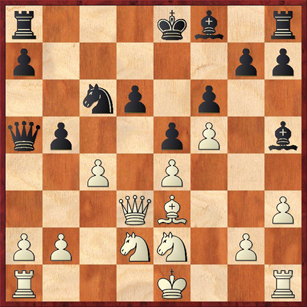I knew that it was a gamble playing in the Cabrillo Quads. First of all, I hate sudden-death time controls, and game/60 is a particularly nasty one. Second, I had a cold and felt as if my thinking was a little bit foggy. And third, I had just spent a week in Hawaii and had not really looked at a chess board in two weeks.
However, I still went because it was the first rated tournament in Santa Cruz county since … well, since I’ve lived here. I wanted to support it so that maybe it will happen again.
The tournament brought out some people who had not played tournament chess in a long time. In the top quad, we had Mike Splane, who used to live in Santa Cruz 20 years ago. We also had Rich Flacco, who (although he is a regular on the local chess scene) had not played in a tournament for 20 years. In short, it was just like old times. I had expected to be the top-rated player, but in fact I was the third person in the quad, and so I knew I would have some hard games.
Alas, I played three really rotten games and finished 0-3. The fourth player in the quad, Romulo Fuentes, took first place at 3-0, and Mike and Rich tied with 1½ points each. First place was worth $100, which is pretty spectacular for a quad with a $15 entry fee ($20 onsite).
My games were so bad that I’m embarrassed to show you any of them. I’ll just show you one representative position. This was from my second-round game against Mike Splane, where I’m playing White. We got to this position:
Black has gotten saddled with a bad bishop, and he has just played the pawn sacrifice 13. … b5!? in order to shake up the position a little bit. My immediate reaction was to play the correct move, 14. Qd5, forcing 14. … Rc8, but after 15. Qxb5 Qxb5 16. cb Nb4 it looked to me as if Black is getting pretty good play for the pawn. So instead I chickened out and played 14. Nc3?, allowing 14. … Nb4 15. Qb1 bc 16. Nxc4 Qc7. White would still be okay after 17. b3, but now I made things even worse with 17. a3?? Things got pretty bad pretty fast after 17. … Qxc4 18. ab d5! with a big advantage for Black.
If you want to see the rest of the game (and the rest of my humiliation), here it is.
What I had to do was look a little harder at other alternatives after 14. Qd5 Rc8, because this is just too good a line to give up on so easily. In fact, the computer recommends 15. Ng3! The point is that after 15. … Bf7 16. Qxb5 Qxb5 17. cb Nb4 White can play 18. O-O (which was not possible with the bishop still on h5). This gets the king out of trouble, and if Black plays 18. … Nxa2 White will remain a healthy pawn up with 19. Bxa7.
I really don’t think that 15. Ng3 should have been hard to find. But I had tunnel vision; I was so determined to get that knight to d5 that I didn’t even think of other possibilities.
Some more general lessons from today’s fiasco: in a game with a quick, sudden-death time control, there is an even higher premium on simple chess. How hard is it, really? If your opponent plays a dubious-looking pawn sac, most of the time the way to refute it is to take it. Make him prove that he has the counterplay! Also, instead of counterattacking with 17. a3, all I had to do was defend my knight with 17. b3. Simple moves. Simple chess. I think that in every game today I got in trouble by playing more complicated and unnatural moves than I needed to.




{ 4 comments… read them below or add one }
Hi Dana, glad you had a nice time in Hawaii! Good to have you back.
I only glanced at the position and the analysis (so I’ve probably some missed some tactical refutation), but after:
18. cxb5 Nb5 19. 0-0 …
Can’t black just play 19. … Nc2, forking the rook and loose bishop on e3?
19. 0-0-0 would stop this, though it would temporarily lose a pawn after 19. … Nxa2+ 20. Kb1 Nb4 21. Bxa7. Even with the queens off the board, white would have a lot of holes in his position and things could get awkward. Actually, 21. Bxa7 looks nasty after 21. … Ra8.
…ha, actually I think I answered my own question. If 19. … Nc2 then 20. Rac1! looks good for white (looks basically winning, actually).
Hi Dana — great post. I have been thinking of my own blind spots these days, looking over my games. It seems I often have trouble looking at both sides of the board at the same time — as though that requires too much traffic between the two hemispheres. 15.Ng3! is exactly the sort of move I would have missed too, being that all the other action is happening on the queenside.
By the way, I thought of you as I posted a piece on The Labourdonnais – McDonnell Attack in the French (starting 1.e4 e6 2.f4 d5 3.e5 c5 4.Nf3). It seems to fit with your Grand Prix repertoire, and I’d be surprised if you did not already play it….
Hi Dana,
I enjoyed reading your notes.
I wasn’t used to the fast time control and also played badly in every game.
I must say, in my defense, that 13. … b5 is the best move in the position. if I don’t play it I get positionally crushed after 14. Nc3
I didn’t see 14. Ng3 as a candidate move either.
I agree that you are still better if you play 17. b3